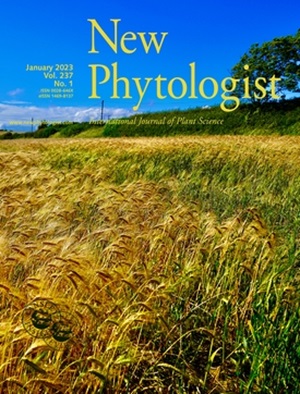Fossil insect-feeding traces indicate unrecognized evolutionary history and biodiversity on Australia's iconic Eucalyptus
IF 8.3
1区 生物学
Q1 PLANT SCIENCES
引用次数: 0
Abstract

昆虫取食化石的痕迹表明澳大利亚标志性桉树的进化历史和生物多样性尚未得到承认。
植物-昆虫食草动物组合化石提供了有关陆地群落在地质年代中组合的基本信息。然而,有关植物与昆虫之间的关系起源于深部时间并持续到现代的化石证据却很少。我们研究了在阿根廷巴塔哥尼亚早始新世 Laguna del Hunco 雨林地点发现的 284 片 Eucalyptus frenguelliana 叶片上的昆虫食草动物破坏情况,并将破坏模式与在大洋洲现存的与雨林相关的桉树物种上观察到的破坏模式进行了比较(查阅了超过 10,000 张标本纸)。在化石材料中,我们确定了 28 种昆虫食草损害类型,包括 12 种外部取食、1 种刺吸、5 种虫瘿和 10 种地雷。标本馆标本中观察到了所有 28 种损害类型。在现存桉树标本上发现的所有损害类型化石表明,多个昆虫食草动物品系与其宿主属之间的长期联系跨越了南半球 5200 万年的时间。这种长期存在可能是由于湿润桉树林中的生态位保护作用,表明了化石历史对现存昆虫食草动物群组成的影响。虽然大多数昆虫的身份仍然未知,但我们提供了一份桉树物种和具体种群地点的清单,以方便发现它们,这突出了化石在发现现存生物多样性方面的相关性。
本文章由计算机程序翻译,如有差异,请以英文原文为准。
求助全文
约1分钟内获得全文
求助全文
来源期刊

New Phytologist
生物-植物科学
自引率
5.30%
发文量
728
期刊介绍:
New Phytologist is an international electronic journal published 24 times a year. It is owned by the New Phytologist Foundation, a non-profit-making charitable organization dedicated to promoting plant science. The journal publishes excellent, novel, rigorous, and timely research and scholarship in plant science and its applications. The articles cover topics in five sections: Physiology & Development, Environment, Interaction, Evolution, and Transformative Plant Biotechnology. These sections encompass intracellular processes, global environmental change, and encourage cross-disciplinary approaches. The journal recognizes the use of techniques from molecular and cell biology, functional genomics, modeling, and system-based approaches in plant science. Abstracting and Indexing Information for New Phytologist includes Academic Search, AgBiotech News & Information, Agroforestry Abstracts, Biochemistry & Biophysics Citation Index, Botanical Pesticides, CAB Abstracts®, Environment Index, Global Health, and Plant Breeding Abstracts, and others.
 求助内容:
求助内容: 应助结果提醒方式:
应助结果提醒方式:


